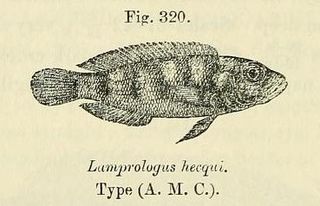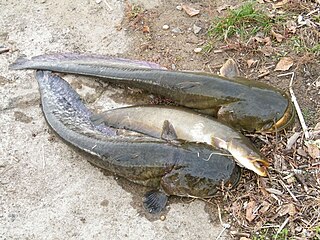Gyrinomimus grahami is a flabby whalefish of the genus Gyrinomimus, found in all the southern oceans.
Atopochilus vogti is a species of upside-down catfish endemic to Tanzania where it occurs in the Wami River. This species grows to a length of 12.6 centimetres (5.0 in) TL.

Clarias maclareni is a critically endangered species of catfish in the family Clariidae. It is endemic to Lake Barombi Mbo in western Cameroon. It is currently threatened because of pollution and sedimentation due to human activities, and potentially also by large emissions of carbon dioxide (CO2) from the lake's bottom (compare Lake Nyos). It is known to grow to 36 centimetres (14 in) TL. Large individuals feed mainly on other fishes (especially cichlids), while smaller individuals mainly feed on insects.

Werner's catfish is a species of airbreathing catfish. It is found in Burundi and Tanzania. Its natural habitats are rivers and freshwater lakes. It is threatened by habitat loss. This species reaches a length of 23.0 cm SL.
Docimodus evelynae is a species of haplochromine cichlid. It is endemic to Lake Malawi; it is widespread in the lake and found in Malawi, Mozambique, and Tanzania. This species has unusual feeding habits: it feeds upon the flank scales of cichlids or cyprinids and the skin of catfishes. The specific name honours Evelyn Axelrod, the wife of the publisher Herbert R. Axelrod (1927-2017).

Docimodus johnstoni is a species of haplochromine cichlid. It is known from Lake Malawi, Lake Malombe, and the upper Shire River in Malawi, Mozambique, and Tanzania. This species has unusual feeding habits: it is reported to feed on fins of clariid catfishes. The specific name honours the British explorer, botanist, linguist and Colonial administrator, Sir Henry Hamilton Johnston, who presented the type to the British Museum.

Lepidiolamprologus hecqui is a species of shell-living cichlid endemic to Lake Tanganyika. This species can reach a length of 8 centimetres (3.1 in) TL. This species can also be found in the aquarium trade.
Pareiorhina rudolphi is a species of armored catfish endemic to Brazil where it occurs in the Paraíba do Sul River near Lorena, São Paulo State, Brazil. This species grows to a length of 4.5 centimetres (1.8 in) TL.
Malapterurus teugelsi is a species of electric catfish endemic to Guinea where it occurs in the Kogon River. This species grows to a length of 21.2 centimetres (8.3 in) SL.
Atopochilus chabanaudi is a species of upside-down catfish endemic to the Republic of the Congo where it occurs in Stanley Pool. It is consumed for food and is threatened by urbanisation of Stanley Pool, water pollution and lead toxicity which comes from car oil and boat traffic. This species grows to a length of 6.0 centimetres (2.4 in) SL.
Atopochilus christyi is a species of upside-down catfish endemic to the Democratic Republic of the Congo. It occurs in the Ituri, Itimbri and Kasai Rivers as well as the Kinsuka Rapids and Boyoma Falls. This species grows to a length of 9.5 centimetres (3.7 in) SL.
Atopochilus mandevillei is a species of upside-down catfish endemic to the Democratic Republic of the Congo where it occurs in the Kinsuka Rapids. This species grows to a length of 14.1 centimetres (5.6 in) TL.

Atopochilus savorgnani is a species of upside-down catfish native to Cameroon where it is found in the Ntem River, Equatorial Guinea where it occurs in Río Muni and Gabon where it is found in the upper Ogowe River.

Microsynodontis polli is a species of upside-down catfish native to Guinea from the Gbin River and Liberia from Saint John. This species grows to a length of 4.1 centimetres (1.6 in) TL.
Atopodontus adriaensi is a species of upside-down catfish endemic to Gabon where it occurs in rapids of the Ivindo, Okano, Ngounié and the Nyanga Rivers. This species grows to a length of 10.0 centimetres (3.9 in) SL. This species is the only described member of its genus.

Silurus soldatovi, Soldatov's catfish or northern sheatfish, is a large catfish species from the Far East.
Gnathophis grahami, or Graham's conger, is an eel in the family Congridae. It was described by Emma Stanislavovna Karmovskaya and John Richard Paxton in 2000. It is a subtropical, marine eel which is known from New South Wales, Australia, in the southwestern Pacific Ocean. It dwells at a depth range of 50–350 metres.

The Pemecou sea catfish, also known as the flapnose sea catfish, the mud cuirass, or the gillbacker, is a species of catfish in the family Ariidae. It was described by Marcus Elieser Bloch in 1794, originally under the genus Silurus. It inhabits marine, brackish and freshwaters in Brazil, Guyana, French Guiana, Colombia, Suriname, Venezuela, and Trinidad and Tobago. It dwells at a depth range of 1 to 5 m. It reaches a maximum total length of 94.2 cm (37.1 in), while males more commonly reach a TL of 30 cm (12 in) and females reach a TL of 62.5 cm (24.6 in). It reaches a maximum weight of 1.5 kg (3.3 lb).
The flapnose sea catfish, also known as the brown sea catfish, is a species of catfish in the family Ariidae. It was described by Theodore Gill in 1863, originally under the genus Leptarius. It inhabits rivers and estuaries in Ecuador, Colombia, Guatemala, Costa Rica, El Salvador, Panama, Honduras, Nicaragua, Mexico, and Peru. It dwells at a depth range of 0 to 15 m. It reaches a maximum total length of 90 cm (35 in), more commonly reaching a TL of 50 cm (20 in).
Pseudolaguvia ribeiroi, the painted catfish, is a species of catfish from Nepal and India. This species reaches a length of 10 cm (4 in).








